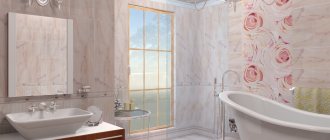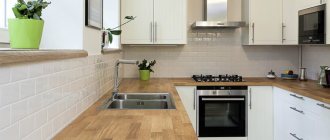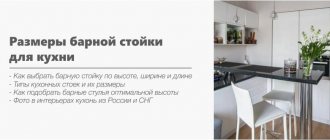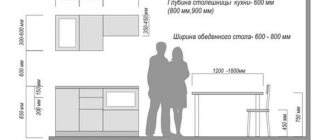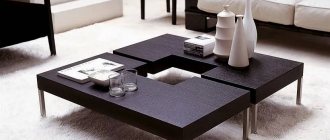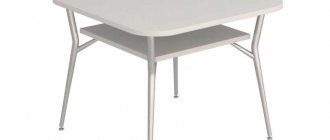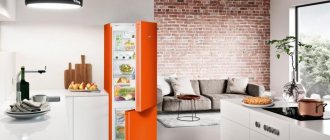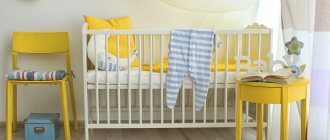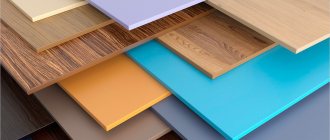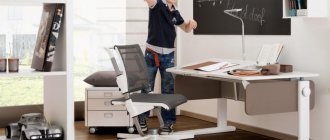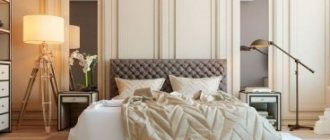MDF is a type of material that is actively used in various construction fields, most often used in everyday life for the manufacture of furniture. Essentially, MDF board is pressed wood.
MDF is an excellent material, its dimensions are ideal for making furniture, tables, cabinets, walls, baseboards and much more.
MDF panels, which are used for wall cladding and for forming cabinet furniture, are obtained by sintering under pressure. It is based on a waste wood resource, namely small chips, as well as an adhesive to form a complete board.
Manufacturing technology
A special technology is used to prepare this material.
Procurement of raw materials
Initially, the resource is harvested. Now the company purchases wood chips or collects them from the production workshop.
The type, quantity of chips and quality of wood depends on the required sizes of MDF sheets and their price changes accordingly.
Wood shavings
Recycled materials are not always used to prepare wood chips; large logs are often taken, which are first cleared of bark and placed in special chopping devices. Next, the chips are washed and heated with steam.
Fiber preparation
Pre-cooking of fibres.
The resulting material is placed in a refiner, which allows the resulting mass to be combined with lignite, as well as some resins, which allows for a bond between wood particles.
Prices for MDF panels depend on the size, type of material, and resins used; the final material can be assessed by photo before purchasing. Next, air is removed from the raw material, and it is dried. Ultimately, the result is an environmentally friendly material, since synthetic components are not used;
Creating a slab
The size of the MDF board and sheet at this stage depends on the size of the walls of the equipment. Essentially, different sizes can be created as long as strength is not lost. The device independently levels the raw materials and creates an even plane, like a carpet, then the edges are trimmed to give an even shape.
Now the pressing process begins. Its main task is to eliminate air inside the stove, which ensures better technical performance.
Final pressing
Now the final stage of preparation begins, when the material is placed under the main press.
Next, the slab is trimmed using a dividing saw. Ultimately, the finished MDF sheet is dried for 30 minutes.
The popularity of the material is due to its affordable price, high strength, and the ability to simply create wide sheets of wood.
Its main properties:
- qualitatively high density indicators - about 800 kg/m3;
- the material is moisture resistant. It is used to produce bathroom furniture;
- thanks to resin impregnation, MDF is not damaged by harmful microorganisms ;
- is resistant to high temperatures;
- the material always remains quite flexible. Resistance to destruction 15 MPa.
MDF and walls
MDF panels are an absolutely natural material: the boards are made from wood shavings and sawdust, crushed, dried and tightly pressed together using paraffin and lignin as a connecting compound. Thanks to the melamine film, the panels can imitate any surface, but most often they are given maximum resemblance to natural wood. The shades of the material can be very different.
The following also speaks in favor of MDF on walls:
- material strength,
- ease of installation
- the ability to implement almost any design ideas with the help of such slabs
At the same time, the surface of MDF - the laminating layer - is easily restored, which not every building material can boast of. The panels are as natural as possible, so they can even be used in children's rooms. In addition, MDF on the walls improves heat and sound insulation in the room.
The disadvantages of panels made from fine particles include:
- The need to mount them on a frame, which hides several centimeters from the area of the room.
- Also, the material should be kept away from potential sources of ignition and moisture - like any wood, MDF is afraid of water and fires.
Application
Its properties have ensured that the material is widely used and used. Most often they are used to form smooth walls or prepare wooden products, especially those that require wide dimensions.
Walls
Thicker versions of MDF boards allow them to be used to form flooring .
Flooring
During operation, good wear resistance is ensured. The main quality of MDF boards is the homogeneity of the material, which makes the product popular both for furniture and acoustic systems.
Furniture
In everyday life, MDF is found most often in: cabinets, chests of drawers, tables, walls, cabinets.
Dresser
Typically, the processing of slabs occurs through the use of milling machines, which makes it possible to apply various beautiful patterns to MDF, producing high-quality finishing and decorating the material.
The sheet is usually sold as a pure resource where no coatings are present. On one side, usually the front side, a layer of plastic is applied. There are options for using sheets with double-sided finishing.
The main differences between MDF panels: sheet dimensions, weight, type of raw materials used, purpose and price.
Painting
In order to cover the panel with soil, it must be specially prepared. It doesn’t matter what size the wall MDF is. The next step is to powder coat both sides of the surface. To apply paint, it is necessary to ensure the appropriate temperature.
Painting will provide a surface with a high level of strength. It will be smooth and will not delaminate when the temperature rises or is exposed to moisture.
It is the use of powder painting that can create an attractive appearance of MDF panels with the durable use of this finishing material.
Painted
Strength and wear resistance are the distinctive features of MDF, the sizes of which are presented in a wide range. We can say that there are no restrictions in choosing the right size. Moreover, the cost of such materials is much more affordable than natural wood.
What material will help create an interior partition? In order to separate the space between rooms, glued, slotted panels are used. They can consist of many elements and, when assembled, look like a panel. This way you can successfully divide the space for work and leisure into zones.
Characteristics
Construction and other areas of application of the material have led to a wide range of different sheets. All options have their own GOSTs and specifications, which directly affect the MDF parameters.
The documents indicate exclusively the qualitative parameters of the final material, and the dimensions can be set by the manufacturer independently. Still, there are generally accepted sizes of material that are more common than others.
- standard sizes of MDF, regardless of the application (interior decoration, facades, furniture), for which the manufacturer is foreign, is a thickness of 3-6 mm, then 8-14 in increments of 2 mm, that is, 8, 10, etc. Here about wall panels for interior decoration;
Standard size
- Most often, such combinations of length and thickness are produced - 2070 × 2800 (2620) mm, as well as 1830 × 2440 mm. Basically, MDF sheets come in these sizes;
- Thicker MDF boards 16, 18, 24 mm have similar dimensions and are only used for specific places with increased strength requirements;
- the thickest sizes are 30-38 mm (counted only in even numbers) and are 2070×2620 and 2700×2800 mm.
Thickness
MDF of non-standard size is much less common, but there are other dimensions of the material. Dimensions for specific areas are especially often changed; for example, there are decorative MDF panels measuring 2700x200x6 mm.
Thanks to the narrow and thin strip, you can prepare unique patterns and make door slopes from MDF, since the dimensions allow you to eliminate a large number of scraps.
Laminated MDF for walls of 10 mm or other thickness almost always have standard sheet dimensions - 2070x2800 mm, although the quality, design and price may vary from different manufacturers.
Laminated
Some types of MDF boards can be classified into separate categories, for example, moisture-resistant MDF for walls will always have smaller dimensions, which is due to the complexity of producing the material.
MDF 16 with moisture-resistant treatment or any other thickness has the same dimensions - 1220 × 2440 mm, the value is specially made from a ratio of 1 to 2 so that it can be laid evenly, since the material will be visible during operation.
Moisture resistant
The size of the slab should be determined based on the task assigned to it. For example, the size of MDF doors will often be long, up to 3 meters, but the width will rarely be more than 1.5 m.
Accordingly, you will have to order either an individual size or assemble it from several pieces, although for most standard modifications (2000x60-80 mm) the standard size is suitable.
For facing tasks, decorative MDF panels measuring 2700x200x6 mm are suitable, the price of which will directly depend on the coating of the material.
When laying MDF on the floor, standard panel sizes or denser ones are suitable. Large sheets can be useful for furniture whose dimensions exceed standard values, these can be walls, cabinets, sofas, and so on.
Often during production, people are faced with the question of what the maximum dimensions of MDF are - among the standard varieties, the size of an MDF sheet of 18 and higher thickness is 2.8 m.
The maximum size of an MDF facade rarely rests on the value of 2.8 m ; usually the height and width of the furniture are much smaller. You can order to order the production of special panels according to your dimensions, then the MDF facades will be prepared holistically and there will be no need to use scraps for missing sections.
A characteristic feature of MDF is that it can be cut to size, and you can choose the appropriate thickness, length, width and density of the material. Decorative options come in a huge variety of sizes, shapes and colors.
Decorative MDF panels measuring 2600x168x13 mm are in high demand if there is a non-standard shape, because the resulting strip is 168 mm wide, 13 mm thick, and 2600 mm long. They are used for small areas of MDF wall finishing.
There are MDF wall panels, their sizes are standard, but what is noteworthy is that they imitate the texture of wood, and the price varies depending on the complexity of the coating.
There are MDF for the wall and with an imitation of a stone pattern, the size and price here are quite the same. Often, MDF panels for the kitchen are covered with plastic, and their dimensions are significantly reduced.
Veneered MDF has standard sizes and is divided into several main varieties: natural wood or fine-line.
Veneered
The main difference is the type and form of processing. Maximum relief and quality of natural wood.
Recommendations for working with plastic when finishing
If the wall is flat, then the material can be attached directly to it. It makes sense to make a frame when you need to cover up old finishes (wallpaper, paint, tiles) or level a wall without plaster.
In addition, the lathing improves sound insulation, helps retain heat, and leaves space for ventilation behind the plastic.
It is economical and easy to make a base from wood. Modern antibacterial compounds contribute to the long service life of wood structures. The bars are installed parallel to the direction of the PVC panels, every 50-60 cm.
The frame is also made from U-shaped plastic profiles. Its advantage is that it is insensitive to moisture, lightweight, does not deform due to temperature changes, and is not electrically conductive.
The profile must be secured in increments of no more than 30 cm, with self-tapping screws or dowels every 0.5-1 m. To join the U-shaped parts together, cuts are made at 90˚, 45˚, 30˚. To secure the plastic, you will need clamps.
To work with panels you will need moldings:
- internal and external corners;
- joints;
- the edges; baseboards;
- finishing elements;
- F-profiles.
Living rooms
If treated with an antiseptic, then the frame in the living room can be made from wooden beams.
The premises are decorated with wood, stone, and white brick. Use decorative, laminated or mirror plastic.
One of the walls can be decorated with PVC material of other shapes. Use rectangular or square structures measuring 0.3-0.98 m, highlight the seams.
Bathroom and toilet
For a bathroom, it is better to make a frame from a galvanized profile or plastic. The material is more suitable without a relief - high humidity can cause mold or mildew, and the textured surface is difficult to clean.
Bathroom panels go well with ceramic tiles, textured plaster, or paint. The main thing is to choose the right shades. It will work out well if you alternate the width and contrast of the elements.
Prints and patterns of different colors will help you create an original design. PVC panels for the bathroom go well with a slatted ceiling, into which mirror inserts can be made.
Kitchens
Economy panels (panels at low prices) can be an inexpensive alternative to ceramics for kitchen decoration.
You can choose combinations of brick and natural stone, mosaic, pattern or ornament.
There are tiled modular options from which images are made; patterns can be combined to decorate the entire kitchen or its individual zones.
A few additional tips:
When purchasing plastic material, you should pay attention to the absence of surface flaws and crumpled joints. There should be no translucency at the stiffeners. Tears and cracks should not form if you lightly press the product. Select the width of the panels so that there is less waste
For small apartments, using a panel with a width of 500-600 mm is impractical. The quality of the material can be checked by bending it. There should be no breaks or cracks. In most cases, the more expensive the material, the better it works. Leave ventilation holes (from fungus and mold).
If you want to make lighting on the ceiling from PVC panels or lamps built into it, it won’t hurt to mark and prepare the holes in advance.
Sizes of different types
An MDF apron for the kitchen has standard dimensions of 4x2440x60 mm; this shape is quite specific, so it is difficult to find another use for it. Here's how to install it.
The dimensions of MDF panels for walls and fittings are often of greater importance, so options are selected that have a length and width of more than 2 meters to ensure a strong frame. The standard size of MDF sheet used for walls is 2500-2800x2070 mm.
The dimensions of MDF boards for walls are rarely selected to be smaller, although sometimes preference is given to narrower options with a size of 1 m, and accordingly the price of this material is slightly lower.
The most common MDF furniture panels have dimensions of 2600x1830 mm; they are almost always used for furniture, since the height is quite enough. The previously described sizes of MDF panels for walls and fittings may differ, since the material can be purchased in almost any size.
The dimensions of MDF sheets and panels for furniture depend on the type of manufacturing method chosen. The sizes and shapes of MDF sheets of 10 mm and other thicknesses are divided into the following types.
Rack and pinion
These are types of material that have long shapes, but are relatively small in thickness and width. Most often, the manufacturer’s assortment includes options with a width from 150 to 325 mm, a thickness of 10 mm ± 4 mm and a length of 2400-2700 mm. Their weight is quite light, which is remarkable.
Rack and pinion
This includes MDF plinth; its dimensions are always within the specified range.
The dimensions of the MDF floor plinth often have a small width, up to 100 mm, a faceted surface and a length of about 2.5 m.
Slat varieties are found in the form of laminated MDF for the ceiling with standard dimensions.
Skirting
Laminated MDF sheet sizes and price depend on the type of application, but usually have the same dimensions as the ceiling options - 2600x150-320 mm;
Tiled
The most striking representative is a wall panel for a kitchen or hallway made of MDF; their dimensions have the correct ratio of length and width.
Tiled
The dimensions of MDF boards range from 30×30 mm and reach 1x1 m, respectively, and the price varies depending on the materials used. The main advantage is that the slabs are lightweight and easy to install. Here is about installing MDF on walls.
Leafy
The most common form, this includes MDF panels for ceilings and MDF screens for heating radiators, which are large in size but very thin.
They have an impressive width - about 1220 mm, a length of 2440 mm, and a thickness of 3 to 6 mm.
Leafy
Thanks to the large sizes, MDF arches are obtained; you can make economical facades from MDF according to your size, arrange walls, ceilings, etc. Here about finishing the MDF ceiling.
The material is often fixed using MDF clamps; the dimensions are extremely small and look like clamps. Clamps for MDF panels have the following dimensions: 20x22x2 mm.
Kleimers
For more information about the sizes of MDF panels, watch the video:
Types of material
There are several of the most popular options for wood fiber panels, which differ in some ways.
Decorative classification:
- Laminated. LMDF are modern materials that are in great demand due to their stable characteristics and a wide selection of colors and textures. A cheaper variety is laminated.
- Veneered. The decorative surface is formed by gluing a thin slice of valuable wood. Such medium-density slabs have a significant thickness.
- Cork. This is the most expensive option. The panel is based on MDF, which gives the product the necessary parameters, and the top layer is made of natural material.
Laminated boards are the most durable, veneer and cork are classified as environmentally friendly products, and painted panels with 3D texture are an exclusive option, but they are not suitable for every interior.
Division by area of use:
- Wall. This category includes slatted products, sheet and tiles. Regardless of the shape, all parts are used for cladding vertical surfaces inside the house.
- Ceiling. This group usually includes materials of small thickness, mainly slatted and sheet. Low weight reduces the load on the suspended structure.
- Furniture. This option is used for the production of the main parts of interior items: facades, decorative inserts and overlays. Although the products can be used for the manufacture of all furniture parts, including children's furniture.
As such, there is no clear distinction between the purposes of MDF; furniture panels are often used to decorate walls and ceilings, and thin wall material is used for furniture decoration.
MDF is also distinguished, which has additional moisture resistance and fire resistance. These indicators are achieved through the use of special modifying additives in production.
conclusions
Other derivatives of the described varieties are determined independently; for example, an MDF tabletop can have individual dimensions that are not subject to any standard. Bent MDF boards are similar; their size is often determined by the size of the cell on which it will be attached.
Often the depth is 70-450 mm, depending on what MDF angles were used, chord sizes range from 250 to 1200 mm. The height does not exceed 2200 mm.
The dimensions of the boards and MDF trim are almost always unchanged in terms of length, only the width changes; usually options up to 700 mm are produced. MDF lining has standard dimensions of 2600x200x7 mm.
Advantages
The convenience of using MDF lies not only in ease of installation, but also in the ability to choose the optimal sizes of wall panels so that there is less waste during the installation process.
Please note that a specific manufacturer may produce MDF in its own line of sizes. The choice of manufacturers is quite diverse. Therefore, to purchase MDF with a certain height and width, you can study offers from different manufacturers. And be sure to choose what you need.
